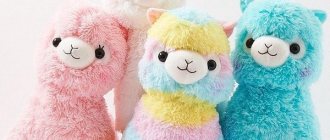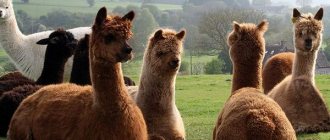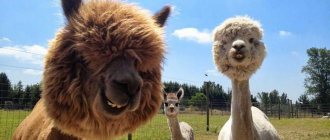Description and origin of the species
The ancestors of llamas lived on the plains of North America about 40 million years ago. Around 3 million years ago, animals migrated to South America as part of the Great Inter-American Exchange, when the Isthmus of Panama first appeared. Even 25,000 years ago, the population in North America was large - llamas lived in the states of California, Texas, New Mexico, Utah, Missouri and Florida. After the Ice Age, llamas disappeared from North America.
The first scientific description of the animal was given by Carl Linnaeus in 1758. Together with alpacas, the scientist attributed llamas to the genus Camel. Since 1800, the animals have been allocated to a separate genus, Lama, along with the guanaco.
There are 4 types of llamas:
- Lama Lama glama
- alpaca Vicugna pacos
- guanaco Lama guanicoe
- Vicugna vicugna
Llama and alpaca are domestic animals, guanaco and vicuna are wild species. Genetic studies have confirmed that the ancestor of the domestic llama is the guanaco, and the ancestor of the alpaca is the vicuña. However, animals interbreed freely with each other, which leads to the appearance of numerous hybrids and blurs the differences between species.
What is the difference between a llama and an alpaca?
The llama is larger than the alpaca and has a more elongated head and rounded ears. The llama grows up to 1.8 meters, the alpaca does not exceed 1 meter in height. Alpaca fur is finer, softer, longer and more valuable, and the color of alpaca wool is richer than that of llama. Similarly, the vicuña (wild alpaca) differs from the guanaco (wild llama) in its more modest size, shorter head and more graceful physique.
Guanaco and vicuna are distinguished by a uniform light brown color interspersed with white. Their domesticated relatives, llamas and alpacas, boast a wider range of colors - white, black, brown, gray and piebald individuals are found.
Alpaca - facts, characteristics and behavior
Alpacas are half the size of llamas and are characterized by having longer, finer coats. They weigh between 45 and 75 kg and are about 4.5 in height when standing. Alpacas have 22 coat colors, including white, blue, black, pinto, brown, fawn, pink, red and grey. There are two types of alpaca depending on the type of wool. Huacaya fiber is dense and crimped, while Suri fiber is white, curly and not crimped. Unlike llamas, alpacas are primarily used for their wool. An adult alpaca typically produces about 1.8 kg of wool each year. Their lifespan is usually around 20-25 years. In the South American region, alpacas are found only in the highlands of the Andes of Peru and Bolivia, and in small populations in northern Chile and northwestern Argentina. They are herbivores and prefer to feed on the vegetation of the Bofedal lowlands.
This is interesting: Man of Mystery. Wolf Messing
What does a llama look like?
An adult animal reaches a height of 1.7-1.8 meters at the top of the head, and weighs from 130 to 200 kg. The height of the animal at the withers is about 120 cm. The neck is long and relatively thin, the head is small and set high. The ears are long, pointed and slightly tilted forward. There is no sexual dimorphism in animals, so it is quite difficult to distinguish a female from a male by appearance.
The llama's build is similar to other members of the Camelidae family, but the animal does not have a hump on its back, unlike a camel. Otherwise, llamas are similar to camels in many ways. Animals chew their cud in a similar way and spit it out when they are unhappy. Both llamas and camels have canine-shaped incisors on the top of their jaws and calloused pads on the soles of their cloven hooves as an adaptation to rocky ground. The long and unusually complex intestines allow llamas, like camels, to live on little water.
Character:
In fact, alpacas are not domesticated. They have been domesticated, but still remain mountain animals. They are even afraid of human touch, but they are quite curious from infancy, which is why they can even get hurt.
Alpacas, unlike other camelids, are quite peaceful. They would never spit at a person, but they do spit at each other when they “fight” for food.
Where does the llama live?
The llama lives in the western part of South America, in the mountain ranges and at the foot of the Andes mountains, in Chile, Ecuador, Peru, Bolivia, and Argentina. These animals were domesticated primarily for transporting goods in inaccessible mountainous areas. In the wild, vicuyas and guanacos live in the highlands, ranging from 3,200 to 4,800 meters above sea level.
Llamas and alpacas were also introduced to North America and have successfully taken root in the United States.
What is alpaca
Now let’s answer the main question: what is alpaca? First of all, alpaca is a domestic animal that is bred on farms for its valuable wool. Breeding artiodactyls from the camel family is a troublesome task, but very profitable for farmers in South America. Alpaca wool is stronger than sheep wool and has rich natural colors. It includes two varieties: suri and huacaya. Raw materials of both types are equally in demand, but the first is valued higher.
The homeland of the animals is Peru. The ancient Indians tamed the alpaca, along with the llama and vicuña. A typical alpaca farm produces an average of 3.5 kg per alpaca. More hair is collected from males. The animal's fur is also valued and is often used to make warm clothing.
Individuals live in high mountain areas, which explains the presence of a thick and dense undercoat. Living at altitudes of 3500–5000 meters, these animals have learned to withstand harsh weather conditions, which is reflected in the quality of their hair.
Suri alpaca obtained from a young individual is characterized by softness, tenderness, and subtlety. The “Baby Suri” label indicates that alpaca is suitable for making children's items. The fiber diameters of baby and soft wool are 22.5 and 25.5 microns respectively, with the coarser alpaca fibers having a diameter of 32 microns. White alpaca is the most valuable species. To obtain raw materials without impurities, farmers have to sort them by hand to remove fibers of a different color.
We found out what it is - alpaca, but did not specify what kind of fabric is obtained from this wool. On sale there are thin and light woolen materials based on camel hair, as well as dense and thick fabrics that are suitable for coats and ponchos. During production, synthetics are added to the fibers - acrylic, polyamide, or the wool of other animals - merino, angora.
Character and lifestyle
Llamas are herd animals and live in a herd. The social status of an animal in a herd is constantly changing, especially for males. Conflicts often occur between males, thanks to which the winners successfully move up the social ladder. Fights between males are spectacular - the animals actively spit, butt and ram each other, kicking each other to knock the enemy down.
Fights between females look much less dramatic - females usually limit themselves to spitting at other members of the herd. You can tell how irritated the llama is by spitting. The more angry the animal is, the less processed chewing gum it uses to spit. Despite small skirmishes among themselves, llamas in the same herd take care of each other. Animals instantly respond to an alarm signal given by one of their relatives and prepare to defend the herd.
In the wild, vicuñas and guanacos live in family groups. The group usually includes one male, from 5 to 15 females, and their offspring. The dominant male expels all males older than 1 year from the herd to eliminate competitors. Exiled males create their own herd, or live alone.
Each group lives in its own territory measuring about 18 square kilometers. The size of the territory varies depending on the availability of food. Wild llamas are very shy. Thanks to their acute hearing, animals are constantly on alert and difficult to take by surprise.
When communicating with each other, the lamas chuckle. As an alarm signal, llamas make a sound similar to barking laughter. When an animal is angry or afraid, it moans, sighs, or makes a loud “mwa” sound. When a llama is anxious or unhappy, it folds its ears back. A happy or curious llama, on the contrary, pricks his ears forward.
Sexually excited male llamas make a specific “eagle” sound, reminiscent of gargling, but more buzzing. Males make this sound from the moment of arousal and during sexual intercourse, which lasts from 15 minutes to 1 hour.
Reproduction and young
Females reach sexual maturity at 12 months, males only at 3 years. Unlike many other animals, female llamas do not go into heat. Ovulation in a female is stimulated from the outside, and occurs right during mating. Pregnancy usually occurs on the first try. Mating occurs in a prone position and lasts approximately 20-45 minutes, which is very unusual for such large animals.
Pregnancy lasts approximately 350 days, that is, about 11.5 months. Females do not lick their babies because the llama's tongue is too short. The animal can stick out its tongue a maximum of 13 mm, so instead of licking, females sniff and sing to their young.
Llamas try to give birth surrounded by a herd to protect the newborn from predators. Labor takes only about 30 minutes and is usually easy, with females giving birth standing up. As a rule, only one cub is born in one litter, weighing from 9 to 14 kg. Just an hour after birth, the little llama is already standing, walking and sucking mother's milk.
Llama milk has low fat content and a higher content of phosphorus and calcium compared to cow and goat milk. At one time, a llama gives only about 60 ml of milk, so the baby has to feed frequently. Because of this, female llamas are never milked.
Social structure and reproduction
Photo: Baby alpaca with mom
By crossing alpacas and llamas, domestic offspring are obtained - Huarisos. But the offspring themselves can no longer reproduce. Llamas, alpacas, and guanacos easily interbreed. Puberty in females begins at 18-24 months, and in males at 24-30 months. They are ready for full mating and fertility after two years.
The mating season is year-round. Reproduction in the wild is “controlled” by the male himself, keeping “strangers” away. And if two or three herds united, fierce battles for primacy take place in the pastures and each leader makes sure that mating does not take place with other males. And in captivity, a person exercises control and selects the most promising and fertile males. Fertilization of a female can be determined by her behavior. Usually she is ready to mate even after giving birth, but if she is already pregnant, she does not allow the male to approach her.
Females are not particularly hardy during pregnancy and miscarriages often occur. The fetus is gestated for eleven months. If the cub is lucky enough to survive, then they are born weighing 1 kilogram and after an hour they are already standing up on their own. It grows actively and by 9 months reaches 35-40 kilograms. Mostly one cub at a time, in rare cases two, both of which subsequently die. At the moment of birth, the herd is nearby; at the level of natural instinct, they are obliged to protect the female and the giving birth alpaca.
How to tame a llama?
The llama needs to be socialized and accustomed to humans only after breastfeeding has ended. In this case, the animal treats the person with curiosity and friendliness. In contrast, llamas that are bottle-fed and tamed to humans too early will be very difficult to handle as adults. If socialized with people too early, adult llamas treat people the same way as their relatives. Early domesticated males often spit, butt and kick people, while females limit themselves to spitting and general unruly behavior.
This condition is called "Lama Berserker Syndrome." The main factors for its occurrence are bottle feeding, too early taming and isolation of the animal from other llamas. As a result, adult llamas do not distinguish humans from their relatives, and try to dominate people. In the most severe cases, males actively bite, kick and attack their owners from behind, attempting to knock the person to the ground.
Castrating males before puberty reduces the chances of berserker syndrome, but neutered males sometimes also exhibit aggressive behavior towards people. Aggressive male llamas with berserk syndrome cannot be retrained, so they are usually euthanized.
However, ordinary llamas without berserker syndrome also often spit at people.
Llamas in the household
Pet llamas are used by people in the following ways:
- like pack animals . Llamas are still used as pack animals in remote areas of the Andean mountains. Animals can carry approximately 25-30% of their own weight, that is, approximately 27-45 kg, over an average distance of 8-13 km, occasionally walking up to 24 km per day. If the load is too heavy, the llama will not walk; it lies on the ground and spits at the driver.
- for wool . Llama fur is less valuable than alpacas, however, the fine wool from the llama's undercoat is used to make clothing. Coarser and tougher guard hairs are used for the production of carpets, tapestries and ropes.
- for meat . Like other livestock, llamas are also eaten. Only males are occasionally slaughtered for meat; females are used only for breeding. In the US, animal meat is not in demand.
- like herding animals . In the United States, llamas are often used to guard livestock such as goats, sheep and alpacas. Only one herding llama is assigned to the herd - a castrated male. If there are several llamas, they get closer to each other and stop caring for the herd.
- in therapy with animals . Communication with animals reduces pain, reduces stress, helps fight illness and depression. In the United States, llamas are used as therapy animals in hospitals and nursing homes.
Population and protection of the species
The llama is a domestic animal that is still actively bred in South America, so the animal population is quite stable. As of 2007, there were more than 7 million llamas and alpacas in South America. About 40,000 more llamas, and about the same number of alpacas, live in the United States.
Wild llamas, vicuña and guanaco, are listed in the International Red Book with the status of a species not causing concern. From the time of the Spanish conquest until 1964, hunting animals in South America was allowed everywhere and was not regulated in any way. Because of this, by the 1960s the vicuña population was on the verge of destruction and had dropped to 6,000 individuals.
The introduction of a ban on hunting, the wool trade and the opening of nature reserves helped restore the population of wild llamas. The vicuna population currently exceeds 350,000 individuals. The ban on trade in vicuña wool has been lifted since 1993. Hunting for wild llama is now permitted only in Tierra del Fuego in Chile.
Appearance and features
Photo: Alpaca animal
Due to the lack of hooves, they are classified as calloused suborder. This callous growth replaces their foot and hoof. Their two-fingered limbs have blunt, curved claws. In the wild, claws wear off on stones and rough rocky plains, and if the pet is kept in a pen, then the claws need to be trimmed periodically. When walking, they rest on the phalanges of their fingers, as a result of which the pastures are not trampled. In pens they need soft flooring in the form of straw.
They tear off vegetation with their lips and chew food with the help of their lateral incisors in a way that their upper teeth are missing. With age, the incisors wear down and gradually grow back. Having thick fur, they thrive in mountains 3 thousand meters high, and are also able to breathe high-mountain air with low oxygen density. The body of a ruminant animal is adapted to process large amounts of vegetation. Throughout the day, they collect food in their unusual stomach with three compartments (other ruminants have four), and in the evening they process it.
Among the ancient Indians, alpaca wool was considered an exchange currency, and manure was considered a valuable and excellent fuel. The skin was used for sewing clothes. Alpaca meat is eaten, but extremely rarely. They will be more beneficial alive.
Currently, wool is considered the highest quality and most expensive. To produce designer items with maximum shine and softness, young alpaca cloth is used. And for carpets and outerwear, the wool of older individuals is ideal.











